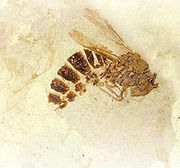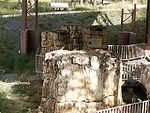
Florissant Fossil Beds National Monument
Encyclopedia

Teller County, Colorado
Teller County is the 22nd most populous of the 64 counties of the State of Colorado of the United States. The county population was 20,555 at U.S. Census 2000. The county seat is Cripple Creek, and the most populous city is Woodland Park...
, that is noted for its fossils. It is located in a mountain valley just west of Pikes Peak
Pikes Peak
Pikes Peak is a mountain in the Front Range of the Rocky Mountains, west of Colorado Springs, Colorado, in El Paso County in the United States of America....
and holds spectacular remnants of prehistoric life. The fossil beds take their name from the nearby town of Florissant, Colorado
Florissant, Colorado
Florissant is a census-designated place and a U.S. Post Office in Teller County, Colorado, United States. The population as of the 2010 Census was 104.Florissant, Colorado, was named after Florissant, Missouri, the hometown of the founding family...
.
The fossils are contained in the Florissant Formation of Eocene
Eocene
The Eocene Epoch, lasting from about 56 to 34 million years ago , is a major division of the geologic timescale and the second epoch of the Paleogene Period in the Cenozoic Era. The Eocene spans the time from the end of the Palaeocene Epoch to the beginning of the Oligocene Epoch. The start of the...
age. Huge petrified
Petrified wood
Petrified wood is the name given to a special type of fossilized remains of terrestrial vegetation. It is the result of a tree having turned completely into stone by the process of permineralization...
redwoods
Sequoia (genus)
Sequoia is a genus of redwood coniferous trees in the Sequoioideae subfamily, of the Cupressaceae family. The only extant species of the genus is the Sequoia sempervirens in the Northern California coastal forests ecoregion of Northern California and Southern Oregon in the United States...
and very detailed fossil
Fossil
Fossils are the preserved remains or traces of animals , plants, and other organisms from the remote past...
s of ancient insects and plants reveal a very different landscape in Paleogene
Paleogene
The Paleogene is a geologic period and system that began 65.5 ± 0.3 and ended 23.03 ± 0.05 million years ago and comprises the first part of the Cenozoic Era...
Colorado. Almost 35 million years ago, enormous volcanic
Volcano
2. Bedrock3. Conduit 4. Base5. Sill6. Dike7. Layers of ash emitted by the volcano8. Flank| 9. Layers of lava emitted by the volcano10. Throat11. Parasitic cone12. Lava flow13. Vent14. Crater15...
eruptions — now designated the Thirtynine Mile volcanic area — buried the then-lush valley and petrified the redwood trees that grew there. A lake formed in the valley, and the fine-grained sediment
Sediment
Sediment is naturally occurring material that is broken down by processes of weathering and erosion, and is subsequently transported by the action of fluids such as wind, water, or ice, and/or by the force of gravity acting on the particle itself....
s at its bottom became the final resting-place for thousands of insects and plants. These anoxic
Hypoxia (environmental)
Hypoxia, or oxygen depletion, is a phenomenon that occurs in aquatic environments as dissolved oxygen becomes reduced in concentration to a point where it becomes detrimental to aquatic organisms living in the system...
sediments compacted into layers of shale
Shale
Shale is a fine-grained, clastic sedimentary rock composed of mud that is a mix of flakes of clay minerals and tiny fragments of other minerals, especially quartz and calcite. The ratio of clay to other minerals is variable. Shale is characterized by breaks along thin laminae or parallel layering...
and preserved the delicate details of these organisms as fossils. Many of the Florissant Formation insect species were described by the entomologist Theodore Cockerell. The Florissant Fossil Beds were set aside as a part of the National Park System in 1969.
"When the mountains are overthrown and the seas uplifted, the universe at Florissant flings itself against a gnat and preserves it."
- —Dr. Arthur C. Peale, Hayden Expedition geologist, 1873.
The visitor center features exhibits about the park's geology and fossils, as well as a video about the site.
See also
- List of fossil sites (with link directory)
- Agate Fossil Beds National MonumentAgate Fossil Beds National MonumentAgate Fossil Beds National Monument is a U.S. National Monument near Harrison, Nebraska. The main features of the Monument are a valley of the Niobrara River, and the fossils found on Carnegie Hill and University Hill....
- John Day Fossil Beds National MonumentJohn Day Fossil Beds National MonumentJohn Day Fossil Beds National Monument is a U.S. National Monument in Wheeler and Grant counties in east-central Oregon. Located within the John Day River basin and managed by the National Park Service, the park is known for its well-preserved layers of fossil plants and mammals that lived in the...
- Raphidia funerataRaphidia funerataRaphidia funerata is an extinct species of snakefly in the Raphidiidae genus Raphidia. The name R. funerata is derived from the Latin funeratus meaning to "bury" or "intern". The species is known from a single female specimen, the holotype, deposited in the Department of Palaeontology at the...
External links and references
- Official park website
- More Park Service information on Florissant Fossil Beds
- Friends of the Florissant Fossil Beds, Inc. - nonprofit Friends of the Park group
- Information on park sites and trails


